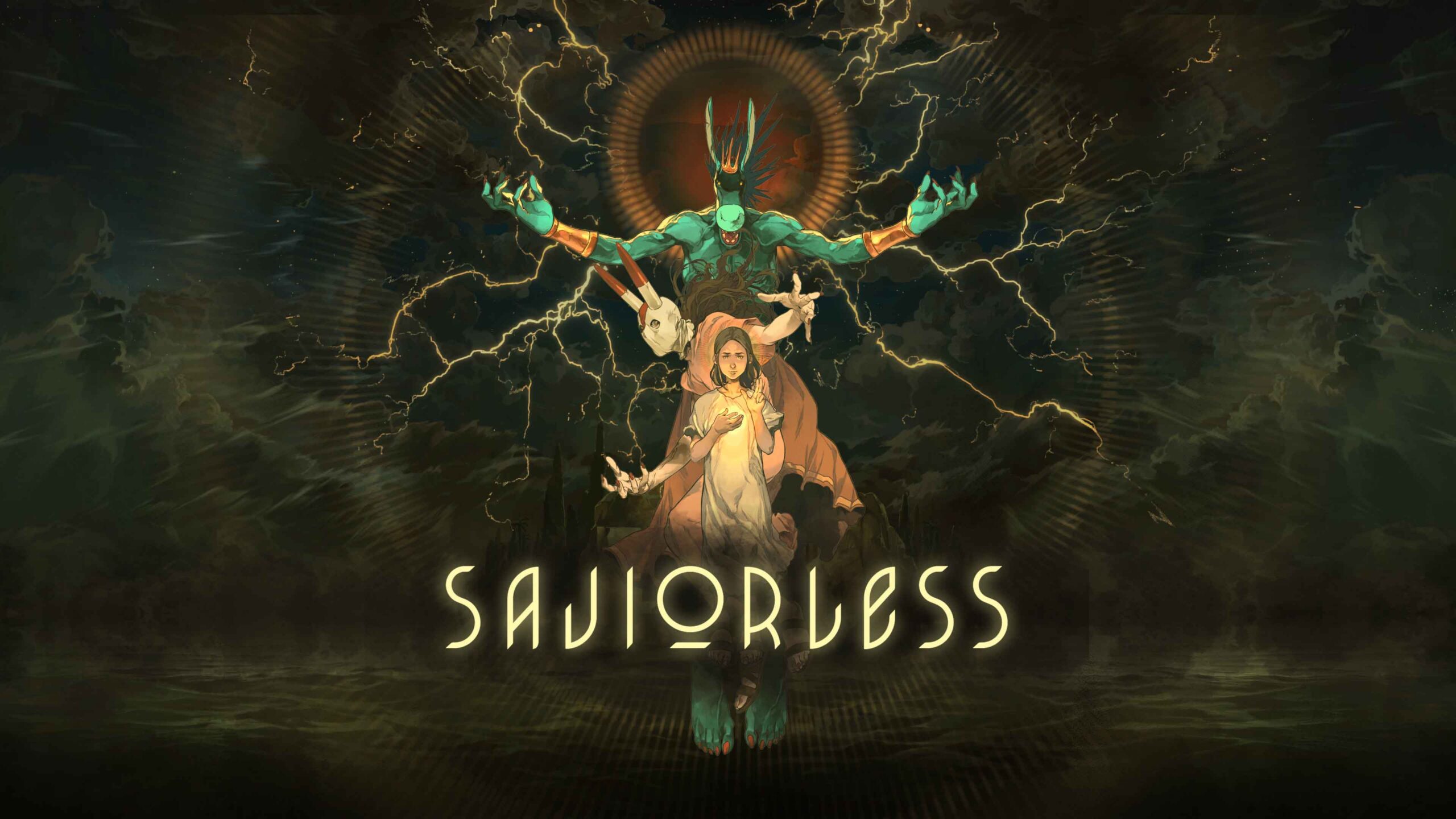
With development that began in 2016, Empty Head Games is proud to finally present to us with Saviorless, Cuba’s first major indie game. The title of the game alone piqued my interest as someone interested in how religion tends to work its way into video games. I would imagine that if you’re reading this article, posted on Catholic Game Reviews, your interest has been piqued as well.
Saviorless is 2-D puzzle-platformer with a pretty interesting setting. The game opens up with a cutscene surrounding an elderly “narrator” teaching his niece and nephew how to become narrators themselves. He teaches the children some pretty strange rules about being narrators (which I’ll return to later), but shortly after that the game begins with the player controlling a young boy, Antar, on a journey to reach the Smiling Islands.
The first thing that immediately popped out to me is the game’s art and visuals. Antar travels through a forest, a cave, some ruined church-like buildings, and a modern facility-type environment, to name a few. All of them have a pretty distinct feel, and throughout all of them, you can see the Catholic influence that comes with a predominantly Catholic country. Most of these references are benign, like the stained-glass windows in the ruined churches. But there are others that are more eye-catching, like jellyfish which have two hand-shaped tentacles, with bloody nails driven through them. In the first half of the game, all of the creatures and enemies in the game have an uncanny valley-like quality to them that can almost be described as cute. But when you need to defeat them or manipulate them in some way to progress, the player is presented with animations that are pretty gruesome; uncannily gruesome in a way that is cartoony, but not funny. Very quickly, the visuals help convey that there is something truly unsettling going on here.

The sounds you hear complement the visuals pretty well. Deaths come with some pretty visceral sound effects, and none felt any more unrealistic than the animations themselves. The music seemed to fit the environments pretty well too. I don’t think there’s anything here that has stuck with me after I’ve played it, but there’s something to be said about the sounds enhancing the gameplay, rather than detracting from it.
Speaking of gameplay, this game is a bit slower paced than some of the marketing material might have you believe. Antar is a boy with no special abilities, so he typically moves slowly. Despite this, he’s still able to solve environmental puzzles to defeat enemies, and you’ll likely find him nimble enough to avoid danger without too much trouble. Some sequences pit you in an arena-style setting in which you have to dispatch a large enemy to proceed; while Antar is hardly equipped to combat these enemies directly, you will still find satisfaction in getting through these encounters successfully.
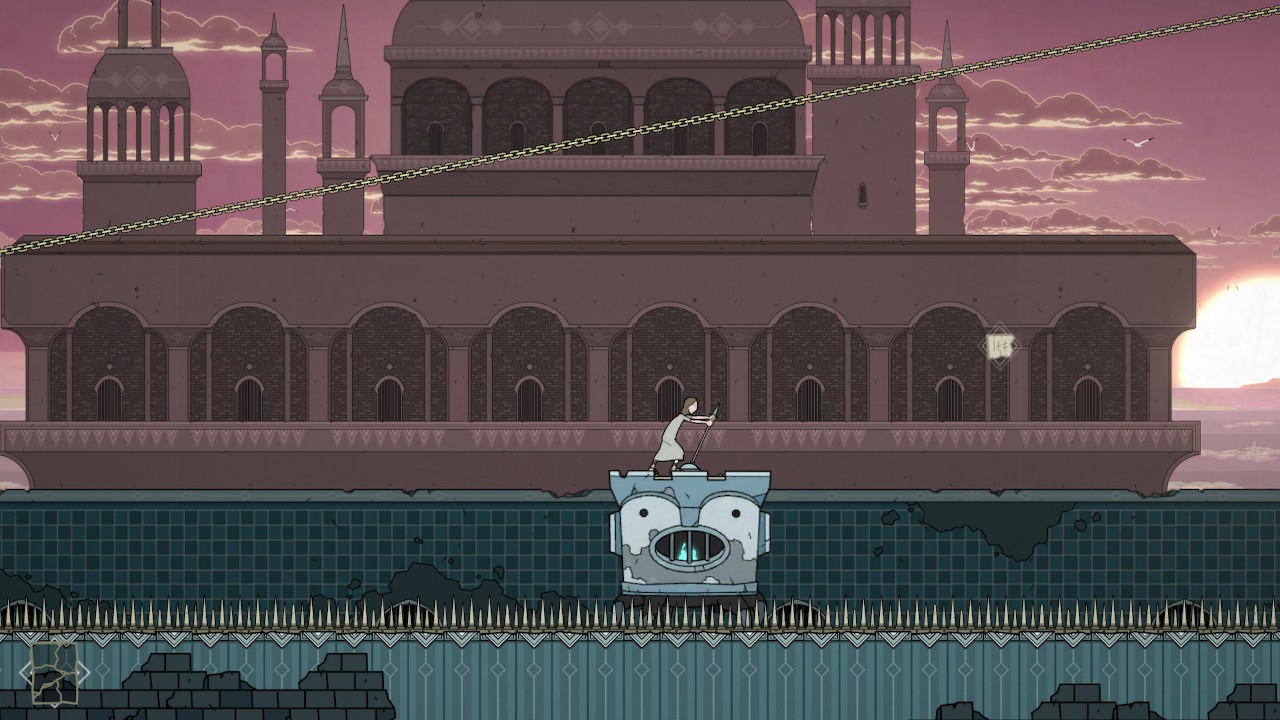
At about the halfway point of the game, Antar gains the ability to become a “savior” (more on this later). When he goes through this transformation, his movement is improved significantly, and he is now encouraged to take enemies head on, akin to an action platformer. But he can’t become a savior at will – only context-sensitive sections of any given level will grant him these enhanced abilities. This is probably because in this amped-up state, he gains a health bar that drains constantly if he’s unable to defeat enemies or destroy objects in the environment. It makes for an interesting change in pace, but due to this health constraint, it still doesn’t quite break out of the puzzle-y nature of the game as a whole.
As far as the story is concerned, the setting might be a little more intriguing than the story within. As mentioned before, the game starts by showing you that you’re about to play as a character in a story, told by narrators who seem to be unreliable, to say the least. The pieces of advice the head narrator gives the two “narrators-in-training” are 1) don’t let the protagonist achieve his goals, and 2) don’t tell the story from the perspective of more than one protagonist.

Shortly after this, you learn more details about the plot behind this story. Antar is following some specific, whimsical methods to reach the Smiling Islands, the only place where he can become an “immortal savior.” As you progress, you discover there’s an antagonist, named Nento, with the same goal, but has been fed up with the whimsical process and has attempted to take matters into his own hands, trying to come up with any possible way to reach the Smiling Islands.
Soon, the narrators-in-training are fed up with their teacher, and decide to break one of his rules, by skipping ahead in the story and allowing you to play as Nento. In doing so, they set a catastrophe in motion – one that isn’t immediately obvious. In fact, it’s not really all that obvious throughout the rest of the game. After some exposition, you’re thrown back into Antar’s shoes, and even Antar himself now sees his surroundings have changed, but never explains nor is he told why.
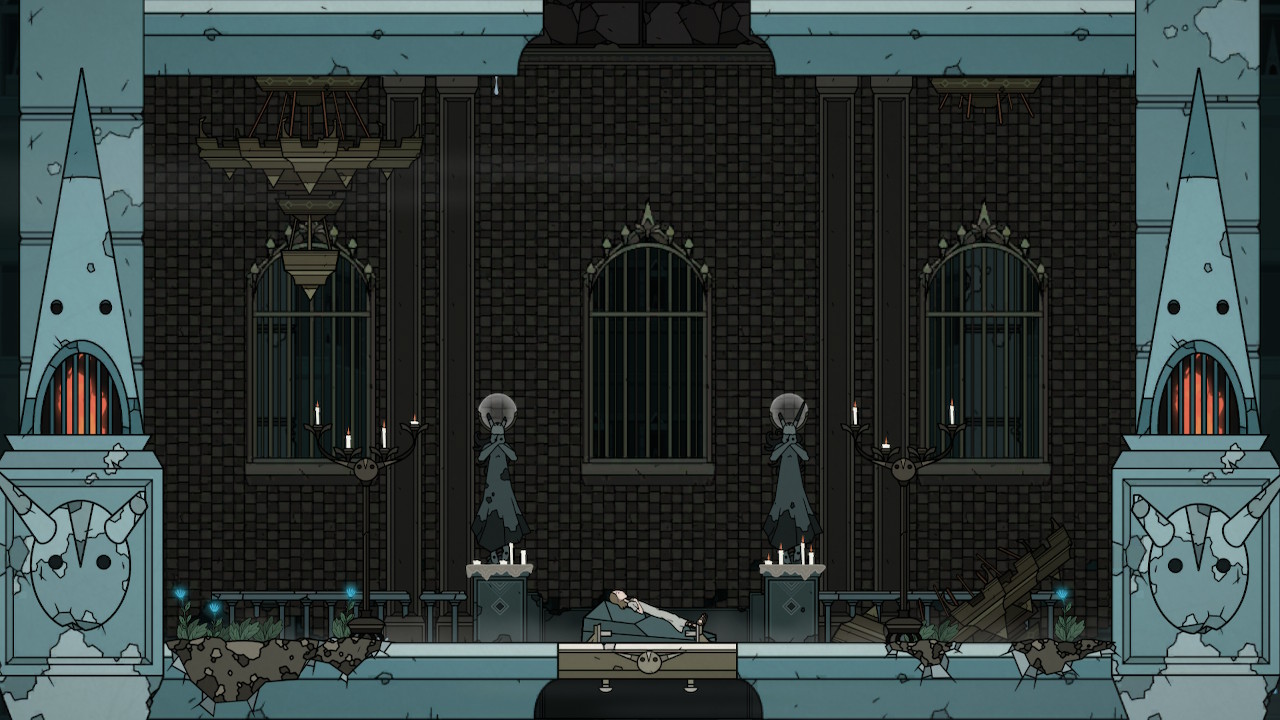
We also never really know what motivates Antar, Nento, or any of the narrators. It almost feels like the game starts in the middle of their stories, rather than the beginning. All of it lends an air of mystery surrounding both the story and characters that is, admittedly, not uncommon in story-telling; the type of narrative device that creators use to say something like “we wanted the player to come to their own conclusions” – which is exactly what the creators have said, believe it or not. But my engineering brain doesn’t take this practice very well. I really ended up being engrossed with this story, especially considering my Catholic perspective on the title of the game, as well as the artistic inspirations found throughout it. So I was just disappointed that I find myself still thinking about what this game might be trying to tell me, rather than having a full understanding of the artistic intent.
As you might expect, Antar does make it to the Smiling Islands, and also gets the opportunity to become a titular “savior.” But immediately – if the foreshadowing brought on by all of the islands’ inhabitantants creepiness hadn’t clued you in yet – you learn that being a “savior” is not as glorious as it seems. You’re presented with the following list of “savior commandments” before you’re able to transform for the first time.
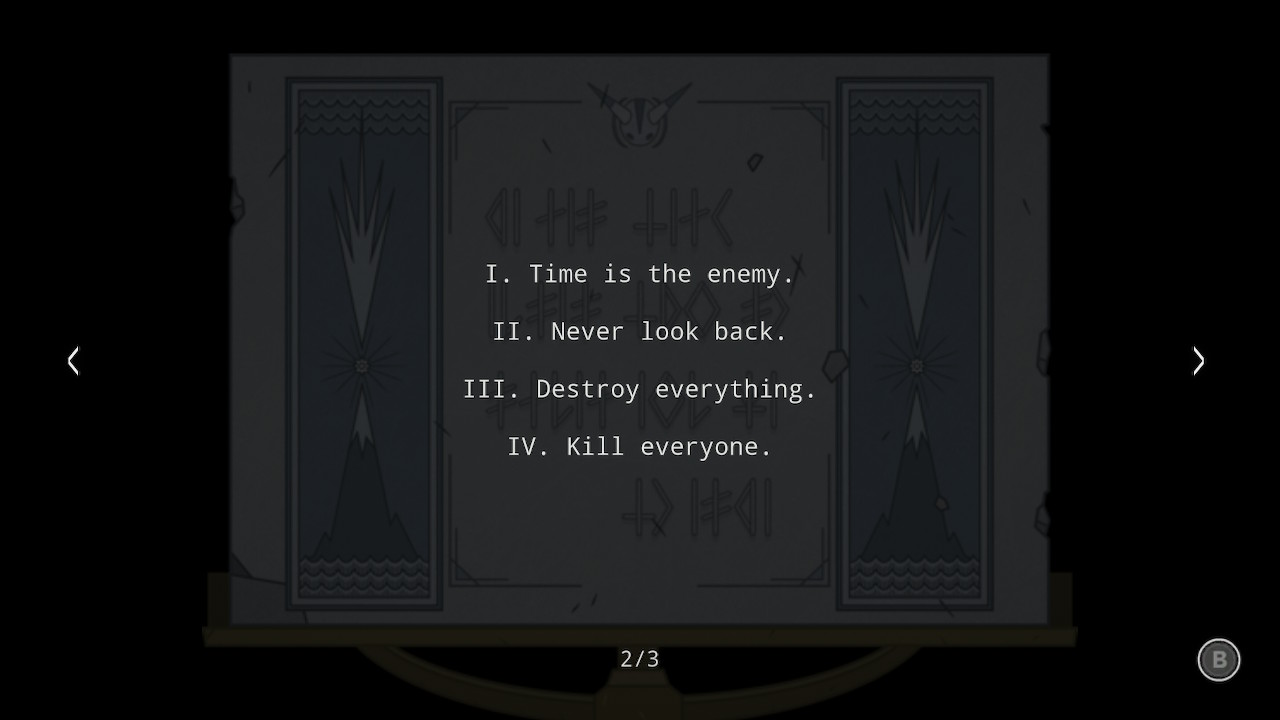
“Kill everyone” is probably not exactly what comes to mind when you think of the heart of the Savior we’re all familiar with. This subversion of my expectations piqued my curiosity, and I had to make sure I got both of the two endings of this game. At the time I played the game, there was no level select screen, so this means I basically played the game twice. Just recently, however, they’ve added a patch to the game that adds a level select feature. And after seeing both of them, I was a little disappointed in both resolutions.
On the surface, the endings provide two possible outcomes of the internal struggle we likely have all faced at one point or another. How do we wrestle with our worldly desires of power and selfishness, and leave them unchecked? The “bad” ending portrays what happens when we lose this battle with ourselves, and the “good” ending is supposed to show us what happens when we’re able to conquer our own demons. But even the “good” ending felt a little lackluster, as it implied that our story is over once we’ve managed to conquer these demons, rather than assume we would ever need to face them again.
In the “good” ending, you also learn why the narrators are so adamant about not allowing the protagonist to achieve their goals. I haven’t quite decided if the end suggests the narrators created the story with a fatal flaw, or perhaps that the narrators in fact did not create the story at all. In either case, viewing this with a Catholic lens more or less excuses the narrators from taking the place of God. God’s creation is perfect, and while we have the ability to abuse it, He always seems to find a way to pull beauty out of our sins when we take His mercy to heart. Exploring the second option, If the narrators were not the creators of this story, then the creator’s absence becomes a little concerning. As I write this now, maybe that is the message Empty Head Games is trying to make – where is our Creator? Maybe I’ll throw in a small paragraph about this in the morality section below… It’s also possible that this story should be viewed not from a cosmic perspective, but from a Cuban perspective. I don’t know that I’ll be able to learn what I need to know about Cuban politics before this review should be published to comment on it here, but I could see that being a plausible interpretation when you consider life under authoritarian rule in general.
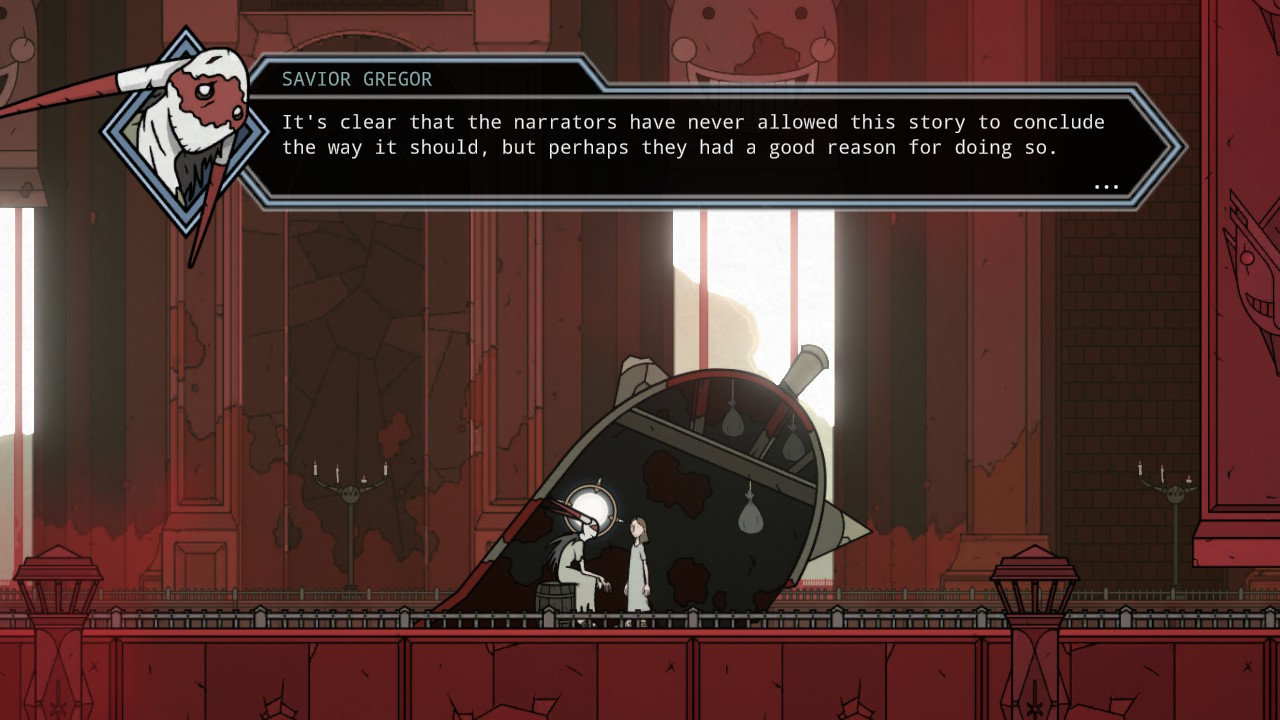
All of this is pure speculation of course. The developer has even stated in an interview that we, as the players, are encouraged to come up with our own interpretations and conclusions about the game (queue the “speculate wildly” gif). And frankly, as I write this review, it’s hard to blame them for not being more forward about what is likely a divisive message. Personally, I’m not a theologian. Am I still qualified to analyze this game from a Catholic point of view? What if there is a message in this game that I’ve totally missed? Will CGR ever let me write a review for them again if I’ve completely missed the mark? I’ve gone ahead and decided to take the risk of writing this review. But I can imagine the developers asked themselves similar questions, and considering all the documented struggles associated with releasing their very first game to begin with – struggles that include half of a two-man team being replaced, multiple significant revisions to the story, and the nature of pushing a game out of communist Cuba – they probably opted not to put one more potential point of criticism. I imagine the struggles of making this game gave the developers plenty of ammo to work with, and there’s certainly some content in Saviorless to think about, outside of the developers simply trying to communicate what they view as moral.
In conclusion, Saviorless absolutely nails the vibe it’s going for. If you’re looking for an intriguing, creepy, beautifully-crafted experience, this game does indeed deliver. But it doesn’t feel like it’s making an impactful commentary on Christianity, or even religion in general. The game opts to use our preconceived notion of the word “Savior,” along with some local artistic inspiration, in service to the unsettling atmosphere of the game above all else. There’s certainly some themes and meta commentary worth exploring and discussing, but I didn’t find anything that gave me a positive new perspective on life, or raised any immediate red flags. All said, this one feels like a good recommendation for anyone looking for a horror experience that isn’t full of jump scares.
Scoring: 78%
Gameplay 4.5/5
Story: 3.5/5
Art and Presentation: 5/5
Music: 4/5
Replayability: 2.5/5
Morality/Parental Warnings
After playing the game, and reflecting on some of the imagery I mentioned above, I was surprised to discover that the game was only rated “T” on its digital storefront. There’s a hefty amount of blood and violence to go around here. My kids are not even close to being teens yet, but I can think of some T-rated games that I wouldn’t be upset if they were exposed to. This one would definitely not sit well with them. But to the rating’s credit, that is all there is to be concerned about here. There’s not even really a hint of sexually suggestive theming or imagery here, and despite the “savior commandments” mentioned above, it’s clear these rules don’t sit well with the protagonist. Even in execution, the protagonist doesn’t have a need or desire to kill anything that hasn’t attacked him first, with the exception of an almost dreamlike sequence associated with the “bad” ending, which is more representative of an internal struggle.
While it’s not totally clear, it’s worth noting that Saviorless might suggest the absence of God or the Creator in our world. As you play through the game, you discover the narrators contend more and more with things they don’t know, which indicates that they do not have complete omniscience over the story like the beginning of the game would have you believe. While not outright criticizing a Catholic point of view, this does run counter to the Catholic belief that God is both all-knowing and all-good. This theme isn’t heavy handed by any means, and due to the intentional ambiguity of the messaging in Saviorless, it’s possible I’m totally overthinking it. I don’t think it would change anyone’s way of thinking, but it’s worth noting there’s some strangeness associated with the assumed creators of the world in the game.
